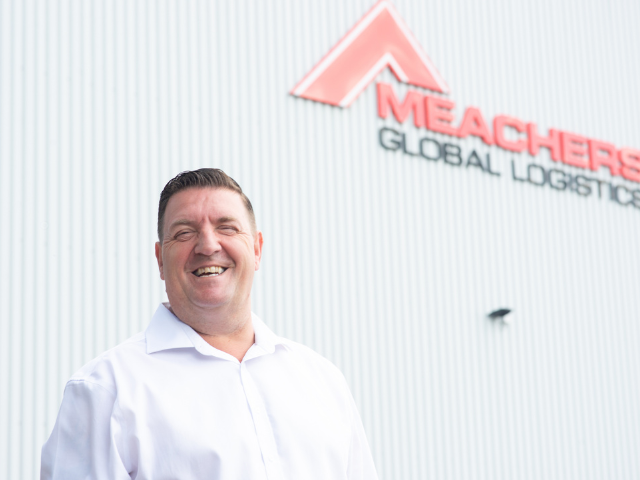In this interview with Gary Whittle, Operations Director at Meachers Global Logistics and recently appointed UK Warehousing Association (UKWA) Chair, we spoke to him about preparing for peak season, tackling technology gaps in warehousing, managing change across multiple sites, and what a future-ready distribution centre should look like.
As Operations Director, How Do You Prepare Meachers' Warehouse & Transport Operations For Peak Trading Periods?
“Managing both physical and human resources during peak and off-peak periods is one of our biggest operational challenges, especially given the ongoing volatility in the supply chain sector. The key to navigating this is proactive communication with all stakeholders and leveraging accurate, timely data.
Once we gain visibility into upcoming demand and potential disruptions, we can begin detailed planning. Our experienced in-house IT team works closely with trusted industry partners to ensure our systems are robust, scalable, and continuously reviewed. We also prioritise infrastructure resilience, including hardware uptime and wireless coverage, to maintain seamless operations across all sites.”
The Role Of IT In Warehouse Logistics Has Evolved Rapidly. In Your View, Where Do The Biggest Knowledge Or Capability Gaps Still Exist In The Sector When It Comes To Successfully Adopting Or Scaling Technology?
“Technology is now central to warehouse efficiency and accuracy. However, a significant gap remains in operational awareness, many of us simply don’t know what we don’t know. That is, we’re often unaware of the full range of technological capabilities available or emerging in the market.
This lack of awareness can hinder progress. Ironically, we’re often too busy managing day-to-day operations to explore innovations that could make us more efficient. Bridging this gap requires dedicated time for research, collaboration with tech partners, and a mindset shift toward continuous improvement.”
Looking Ahead, Which Technology Investment Are Priority And How Do You See Them Impacting Fulfilment Speed, Accuracy & Costs?
“Artificial intelligence and robotics are high on our radar. We see significant potential in both to enhance operational speed, accuracy, and cost efficiency. However, timing is critical. We need to ensure that any investment is thoroughly researched and aligned with our operational needs and growth trajectory.
We’re also mindful that many in the industry face similar challenges, balancing innovation with practicality. Our approach will be measured, ensuring that each step forward delivers tangible value.”

Adopting New Systems Often Requires A Cultural Shift As Much As A Technical One. How Do Your Approach Change Management & Workforce Engagement When Rolling Out Technology Across Multiple Warehouses?
“Change management is a constant challenge in our sector, but it should never be a barrier to progress. At Meachers, we’ve found that early engagement with internal stakeholders is key. When teams are involved from the outset, they take greater ownership of the change, leading to smoother implementation and better outcomes.
Equally important is choosing the right IT partner. Cultural alignment between our organisation and our technology providers ensures a more collaborative and effective rollout.”
What Are The Most Persistent Challenges Meachers Faces Around Connectivity & How Do You Stay Ahead of Them?
“Currently, we experience minimal issues with connectivity or system reliability, thanks to our proactive IT strategy. However, like the rest of the industry, we face ongoing market volatility, which complicates resource planning and asset management.
To stay ahead, we rely on strong communication, regular performance reviews, and detailed KPI analysis. These tools help us anticipate issues and respond quickly when challenges arise.”
If You Had A Blank Slate To Design A New Flagship Distribution Centre, What Technologies Or Design Principles Would You Prioritise To Maximise Scalability, Resilience & Long-Term Operational Performance?

“The design would depend heavily on the size, location, and client base of the operation. That said, our priority would be to fully understand the supply chain requirements and resource the facility accordingly.
Key principles would include modular design for scalability, integrated automation for efficiency, and robust IT infrastructure for resilience. As always, success would hinge on thorough planning and clear communication from the outset.”
When It Comes To Gearing Up For Seasonal Urges Or Unexpected Demand Spikes, What Strategies Have Proven Most Effective At Meachers For Maintaining Performance & Minimising Disruption?
“Our most effective strategies combine market insight, trend analysis, and proactive communication. By understanding seasonal patterns and client expectations, we can build resilience into our solutions and minimise surprises.
When unexpected challenges do arise, as they inevitably will, we focus on resolving them quickly and efficiently using the resources at our disposal. Flexibility, transparency, and a problem-solving mindset are essential.”
With 400,000 AGV’s running on DTE-designed Wi-Fi, 500m+ sq. ft. of coverage delivered, 160+ warehouse projects delivered last year, and a 100% safety record – DTE knows how to make warehouses perform at their peak. For more information on how we can support your warehouse operations, get in touch.

Written by Carl Resch
Head of Marketing
Carl Resch is DTE’s Head of Marketing, bringing over 10 years of experience in shaping strategy, driving brand growth and delivering impactful campaigns. CIM-qualified, he enjoys understanding what resonates with audiences and creating clear, purposeful content that gets straight to the point.
Speak With An Expert
Submit your details below and we’ll be in touch.

